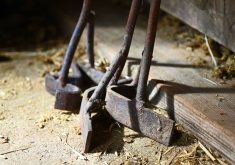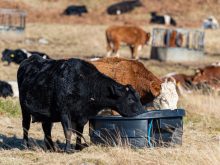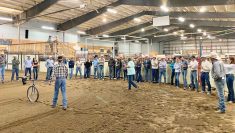A ranch manager from near Longview Alberta took home the hardware earlier this year at the first-ever Ultimate Stockmanship Challenge held at the Pincher Creek Rodeo grounds in southern Alberta
Wolter Van der Kamp, who has worked with livestock in various capacities over his career, won the top two classes of the competition designed to test the abilities of competitors in low-stress, safe livestock handling techniques.
Van der Kamp won both the on-foot challenge and the horseback challenge in handling groups of cattle.
Read Also

Harvest wraps up and fall work begins
At the Eppich famly ranch in western Saskatchewan, the fall harvest was successful with few breakdowns, cows and calves have been sorted and a new tractor has arrived
About a dozen participants had just completed a school in July learning the Bud Williams low-stress livestock-handling techniques. The competition was a chance for them to put the information into practice.
Van der Kamp was born in the Netherlands and grew up on a dairy farm. During his years in Canada he became a packer and tour guide in Banff National Park, then spent time in Australia at a cattle station. When he came back to Canada he worked at Douglas Lake Ranch in British Columbia and Simpson Ranch in Alberta. He now manages a ranch west of Longview.
Runner-up in the on-foot division was Marcha Duvenage, an Alberta horse trainer who competes with and trains reined cow horses. She says she did better in the on-foot competition than on horseback because she has never owned cattle or spent much time with cattle. “I’d never worked them on foot but was able to use Bud Williams’ methods taught us in the clinic; I simply did what they told me to do!”
Runner-up in the horseback division was John Smith of the Plateau Cattle Company near Nanton, Alta. He is a third-generation rancher and has been interested in low-stress stockmanship for a long time.
The event was organized and hosted by local ranchers Malcolm and Jenny MacLean and sponsored by Zoetis, The Western Producer, Country Vets Ltd, and Prairie Wind Hatworks.
The Bud Williams low-stress stockmanship school was conducted by Dawn Hnatow and Whit Hibbard. They and Paul Kernaleguen were judges for the weekend challenge. Hnatow is from Texas but originally from Alberta. She worked with Bud Williams for 10 years at the feedlot at Lloydminster and was one of the students who worked with him the longest. Hibbard also worked with Bud Williams and on his family’s fifth-generation ranch in Montana. He was a park ranger for many years, rounding up cattle that were illegally grazing. Kernaleguen is a dairyman in Saskatchewan.
Starts in the classroom
The school was an introduction to livestock handling methods developed by Bud Williams. Williams, who died in 2012, was a well-known U.S.-based expert on low-stress handling of livestock.
Topics of the workshop included benefits of low-stress methods compared with traditional/conventional cattle handling. Basic elements involved having the correct mindset and attitude, “reading” an animal, preparing and handling cattle and understanding the principles and techniques of low-stress handling. Practical applications included driving cattle, corral work and facilities, crowd pens, chute work, scale loading and loading cattle onto trucks and trailers.
The goal of the school and the two-day competition was to give participants enough understanding and experience to go home and successfully apply these techniques on their own ranches or cattle-handling jobs.
Malcom MacLean says he created the event as a way to get more people aware of low-stress cattle handling because it’s not common on most ranches, feedlots and grazing reserves.
“There are many rodeo-type events and competitions, but the cattle get worse instead of better,” he says. “I wanted to put on an event in which nothing is sacrificed, and the cattle, horses, and people are better when they leave than when they came.
“It was fun to watch and participate in because having a single person deal with multiple cattle through obstacles made it like a game of chess. The competitors learned a lot, the cattle learned a lot and everyone had a great time.”
The competition was based on daily ranch and feedlot cattle work. The requirements included being able to properly and efficiently work a Bud Box, load a line chute, sort cattle, doctor cattle, drive a group of cattle, corral cattle, and pull a pen as well as a single animal. This had to be done with no driving aids (flags, sticks, canes), and no yelling or physically contacting cattle.
“We had the on-foot category because there are many people who move cattle without horses, and we wanted to show that this style of cattle handling can be done both on foot and on horseback,” says MacLean.
Challenging course
“I created a challenging course so people would have to use Bud Williams’s methods to get the cattle successfully and efficiently through the course within an allotted time. This was not a timed event but there was a time limit to complete the pattern. Some weren’t able to complete it, not knowing the correct moves to get the cattle where they wanted them, and reverting back to their conventional handling styles.”
During the second day of competition participants were given two lifelines, like on ‘Who wants to be a millionaire?’ If they got stuck on a particular aspect of livestock handling, they could ask the judges for advice. They could suggest an applicable Bud Williams method for a particular situation. When the competitor applied the technique, the cattle would respond and they’d be off to the next obstacle.
Van der Kamp says the low-stress techniques work well on their ranch. “We graze on a lot of forestry and leased land,”he says. “When I first got here, we struggled to keep cattle off the highway and where they should be, especially in forestry lands. In those big pastures I started to focus on stockmanship and how to make cattle want to stick together.”
Van der Kamp had studied low-stress livestock handling, including articles and workshops by well-known Alberta beef producer Dylan Biggs, as well as reading about techniques written by Bud Williams and others.
“I read a lot, including Bud Williams’s articles,” he says. “I also saw a video on Bob Kinford’s Instinctive Migratory Grazing methods. This was especially interesting because on our forestry grazing we can’t fence it into small paddocks. I needed to teach the cattle to be a herd and stick together,”
MacLean says the plan is to organize another Stockmanship Challenge for 2023. “The number of competitors this year was perfect,” he says. “If there’s a lot of interest next year, we may add more days and have an advanced, intermediate, and beginner class. Our hope is to continue this as an annual event to stimulate more interest in low-stress stockmanship.” GN















